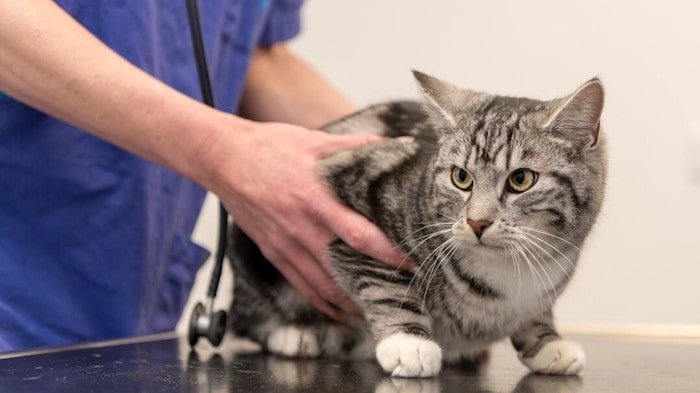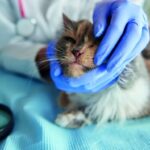Just like humans, cats can experience thyroid problems, and hyperthyroidism is one of the most prevalent thyroid disorders found in felines. This condition occurs when the thyroid gland becomes overactive, producing an excess amount of thyroid hormones. Hyperthyroidism can have a significant impact on a cat’s overall health and quality of life if left untreated.
In this article, we will unravel the mysteries surrounding hyperthyroidism in cats. We’ll explore its causes, delve into the telltale signs and symptoms to watch out for, and discuss the various diagnostic methods used to confirm this condition in our feline friends. Additionally, we’ll dive into the available treatment options and provide helpful tips for managing and supporting cats with hyperthyroidism.
Whether you’re a concerned cat owner seeking answers or simply curious about feline health, this comprehensive guide will equip you with valuable knowledge to better understand hyperthyroidism in cats. So, let’s embark on this informative journey and empower ourselves to provide the best care possible for our furry companions.
What is Hyperthyroidism in Cats?
Hyperthyroidism in cats is a condition where the thyroid gland produces too much of the hormone thyroxine, which regulates the metabolism and other body functions. This can cause a range of symptoms in cats, such as weight loss, increased appetite, vomiting, diarrhea, hyperactivity, and heart problems.
The thyroid gland is located in the neck, on either side of the windpipe. It produces several hormones, mainly thyroxine (T4), that affect many aspects of your cat’s body, such as:
- Body temperature
- Fat and carbohydrate metabolism
- Weight gain and loss
- Heart rate and cardiac output
- Nervous system function
- Growth and brain development in young animals
- Reproduction
- Muscle tone
- Skin condition
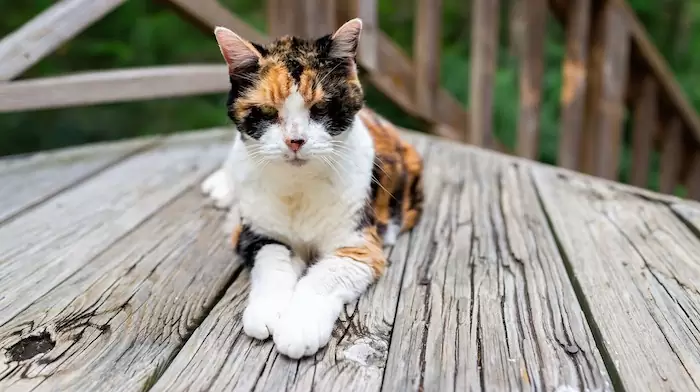
When the thyroid gland produces too much thyroxine, it causes your cat’s metabolism to speed up and burn more energy than normal. This leads to weight loss despite increased appetite, as well as other symptoms of hyperthyroidism.
Hyperthyroidism is the most common hormonal disease in cats, especially in older ones. The average age of diagnosis is approximately 13 years. The possible age range is 4-20 years, although seeing young hyperthyroid cats is very rare.
Hyperthyroidism can have serious consequences for your cat’s health if left untreated. The excess thyroid hormones can put a strain on your cat’s heart, kidneys, liver, and other organs, leading to complications such as:
- High blood pressure (hypertension)
- Heart disease (hypertrophic cardiomyopathy)
- Kidney disease (chronic kidney disease)
- Liver disease (hepatic lipidosis)
- Eye problems (retinal detachment, blindness)
- Neurological problems (seizures, tremors, weakness)
Causes of Hyperthyroidism in Cats
The exact cause of hyperthyroidism in cats is not known, but it is usually due to a benign tumor (called an adenoma) in the thyroid gland that makes it overactive. The thyroid gland is located in the neck, on either side of the windpipe. It produces several hormones, mainly thyroxine (T4), that affect many aspects of your cat’s body, such as:
- Body temperature
- Fat and carbohydrate metabolism
- Weight gain and loss
- Heart rate and cardiac output
- Nervous system function
- Growth and brain development in young animals
- Reproduction
- Muscle tone
- Skin condition
When the thyroid gland produces too much thyroxine, it causes your cat’s metabolism to speed up and burn more energy than normal. This leads to weight loss despite increased appetite, as well as other symptoms of hyperthyroidism.
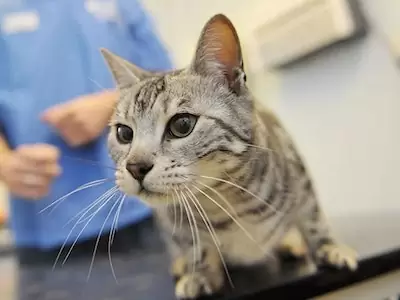
Some factors that may contribute to the development of hyperthyroidism include:
- Diet: Some reports have linked hyperthyroidism in cats to some fish-flavored canned food diets that may contain high levels of iodine or other substances that affect thyroid function.
- Environment: Some studies have suggested that exposure to certain chemicals or pollutants in food or water may disrupt thyroid function or increase the risk of thyroid tumors.
- Genetics: There is no known genetic predisposition for hyperthyroidism in cats, but some breeds may be more susceptible than others. For example, Siamese and Himalayan cats may have a higher incidence of hyperthyroidism than other breeds.
Symptoms of Hyperthyroidism in Cats
Cats with hyperthyroidism may show a variety of symptoms that may be subtle at first but become more severe as the condition progresses. Some of the most common symptoms are:
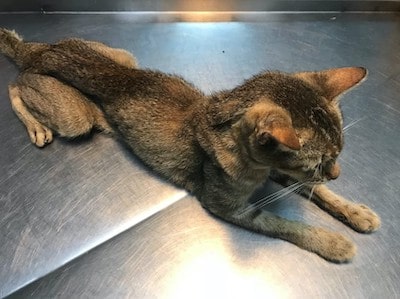
- Weight loss: Despite having an increased appetite and eating more food, cats with hyperthyroidism lose weight because their metabolism is too high and they burn more calories than they consume.
- Unkempt appearance: Cats with hyperthyroidism may have a poor coat condition, with matted, greasy, or dull fur. They may also have thickened nails and skin problems.
- Vomiting and diarrhea: Excess thyroid hormone can cause gastrointestinal disturbances, such as vomiting, diarrhea, or constipation. These can lead to dehydration and electrolyte imbalance.
- Increased thirst and urination: Cats with hyperthyroidism may drink more water and urinate more frequently because of their increased metabolic rate and kidney function. They may also develop kidney disease as a complication of hyperthyroidism.
- Rapid breathing and heart problems: Hyperthyroidism can affect the respiratory and cardiovascular systems, causing rapid breathing, difficulty breathing, coughing, heart murmur, high blood pressure, and heart disease. These can be life-threatening if left untreated.
- Hyperactivity and restlessness: Cats with hyperthyroidism may be more active, restless, nervous, or aggressive than usual. They may also have trouble sleeping or relaxing.
- Enlarged thyroid gland: In some cases, cats with hyperthyroidism may have a palpable lump on their neck, which is the enlarged thyroid gland. However, not all cats with hyperthyroidism have a visible or palpable thyroid enlargement.
Treatment Options for Hyperthyroidism in Cats
There are four main treatment options for hyperthyroidism in cats: medication, radioactive iodine therapy, surgery, and dietary therapy. Each option has its advantages and disadvantages, and the best choice depends on the individual cat’s health status, owner’s preference, and financial considerations.
1) Medication: The most common medication used to treat hyperthyroidism in cats is methimazole (Tapazole), which blocks the production of thyroid hormone by the thyroid gland. Methimazole can be given orally as a pill or liquid, or applied topically as a gel on the ear.
Methimazole is effective in controlling the symptoms of hyperthyroidism in most cats, but it does not cure the condition and must be given for life.
Methimazole can also cause side effects such as vomiting, loss of appetite, itching, bleeding disorders, liver problems, or allergic reactions. Cats on methimazole need regular blood tests to monitor their thyroid levels and liver function.
2) Radioactive iodine therapy: This is considered the gold standard treatment for hyperthyroidism in cats. It involves injecting a radioactive form of iodine (I-131) into the cat’s bloodstream, which selectively destroys the abnormal thyroid tissue without harming other organs.
Radioactive iodine therapy can cure hyperthyroidism in most cases with one injection and has few side effects. However, it is expensive and requires specialized facilities and staff.
Cats treated with radioactive iodine therapy need to be hospitalized for several days until their radiation levels are safe for discharge.
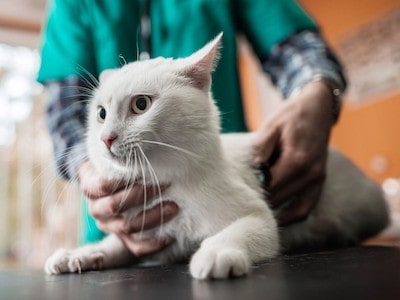
3) Surgery: This involves removing one or both lobes of the thyroid gland surgically. Surgery can cure hyperthyroidism in most cases, but it has some risks and complications, such as bleeding, infection, damage to the parathyroid glands or the laryngeal nerves, or recurrence of the condition.
Cats who undergo surgery need general ane sthesia and post-operative care. They may also develop hypothyroidism (low thyroid hormone levels) after surgery and require lifelong supplementation of thyroid hormone.
4) Dietary therapy: This involves feeding the cat a prescription diet that is low in iodine, which is essential for the synthesis of thyroid hormone. By limiting the iodine intake, the diet can reduce the production of thyroid hormone by the thyroid gland and control the symptoms of hyperthyroidism.
Dietary therapy can be a safe and effective option for some cats, but it has some limitations, such as difficulty in transitioning the cat to the new diet, lack of palatability, or interference with other medications. Cats on dietary therapy need regular blood tests to monitor their thyroid levels and nutritional status.
How Can I Prevent or Manage Hyperthyroidism in My Cat?
There is no sure way to prevent hyperthyroidism in cats, but you can take some steps to reduce the risk or manage the condition:
- Feed your cat a balanced and high-quality diet that meets their nutritional needs
- Avoid feeding your cat fish-flavored canned food or treats that may contain high levels of iodine or other substances that affect thyroid function
- Limit your cat’s exposure to chemicals or pollutants that may disrupt their thyroid function
- Monitor your cat’s weight, appetite, behavior, and energy levels regularly
- Take your cat to the vet for routine check-ups and blood tests
- Follow your vet’s recommendations for treatment and follow-up care
FAQ
How is hyperthyroidism diagnosed in cats?
Hyperthyroidism is typically diagnosed through a combination of physical examination, blood tests to measure thyroid hormone levels, and sometimes additional diagnostic imaging such as ultrasound or scintigraphy
What are the potential complications of untreated hyperthyroidism in cats?
If left untreated, hyperthyroidism in cats can lead to severe complications such as heart problems, high blood pressure, kidney disease, and other organ dysfunctions. It is crucial to seek veterinary care to prevent further health complications.
Can hyperthyroidism in cats recur after treatment?
In some cases, hyperthyroidism can recur after treatment, especially with medication or surgery. However, if treated with radioactive iodine therapy, the chances of recurrence are significantly reduced.
Can a cat with hyperthyroidism still have a good quality of life?
Yes, with proper diagnosis and treatment, cats with hyperthyroidism can still have a good quality of life. Early detection, appropriate management, and regular veterinary care can help control the condition and improve the overall well-being of the cat.
Conclusion
In conclusion, hyperthyroidism in cats is a common condition that requires attention and proper management. By familiarizing ourselves with the signs, symptoms, and treatment options available, we can take proactive steps to ensure the well-being of our feline companions.
If you suspect that your cat may be experiencing hyperthyroidism or if you have noticed any unusual changes in their behavior or health, it is crucial to seek veterinary care promptly. Early detection and intervention play a vital role in managing the condition and preventing potential complications.
Remember, hyperthyroidism can be effectively managed through a combination of medication, radioactive iodine therapy, or surgical intervention. Your veterinarian will guide you in determining the most suitable treatment approach based on your cat’s individual needs.
Additionally, providing a balanced diet, administering medications as prescribed, and creating a stress-free environment can significantly contribute to your cat’s overall well-being. Regular veterinary check-ups will help monitor their condition and make any necessary adjustments to the treatment plan.

